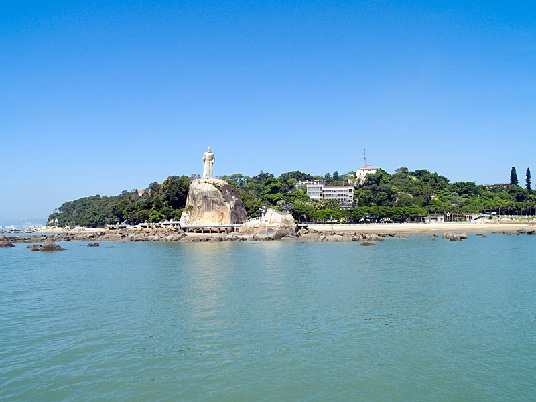Gulangyu Island is located in the southwest corner of Xiamen City. Visitors can reach it by steamship from Xiamen in about 5 minutes. The Island looks across the sea to Xiamen City, separated from Gulangyu by Lujiang of 600 m wide. With an area of 5 square kilometers and more than 20,000 people, it is in the jurisdiction of Xiamen. During the Ming Dynasty (1368-1644), the island was called 'Yuanshazhou' (or Yuanzhou Tsai). It got its present name from the huge reef surrounding it. When the tide comes in, the waves pound the reef and it sounds like the beating of a drum. The island came to be named 'Gulang'. Gu in Chinese means 'drum', and Lang, 'waves'. With classical and romantic European-style architecture, the island truly deserves to be called the'Architecture' as the result of history. It is also known as the 'Cradle of Musicians' and 'Island' because of its reputation for music appreciation. The island is fertile ground for talents of music, having the most density of pianos and ranking first in the nation, thus obtains the good reputation of “Island of Music” or "Piano".
The climate of the island is favorable and like spring all the year round, without the uproaring of cars and horses but heard the chirps of birds and smelt with fragrance of flowers, hence the name “Garden on the Sea”. Gulangyu Island has major sights worth seeing including, Sunlight Rock,Shuzhuang Garden, the Bright Moon Garden, Yu Park, the Island Ring Road, Gulangyu Stone, Xiamen Museum, Memorial Zheng Chenggong, Underwater World and natural bathing beach, becoming a comprehensive island scenery and cultural scenic area with the combination of sight-seeing, vacation, tourism, shopping, leisure and entertainment. It is national scenic area and listed among the top ten scenic area of Fujian as well as one of the most 35 famous scenic spots of the country. With the soaring of Xiamen Special Economic Zone, various systematic services of tourism in Gulangyu is increasingly becoming perfect. Gulangyu Island of Xiamen was officially approved by the National Tourism Administration to be the national AAAAA scenic area on May 8, 2007.











